- Top Employee Onboarding Software
- Why Use Employee Onboarding Software?
- Key Features of Effective Onboarding Software
- How To Choose The Right Onboarding Software?
- Which is the Best Onboarding Software?
- Frequently Asked Questions (FAQs)
- What Is Upskill And Reskill?
- Difference Between Reskilling And Upskilling
- Upskilling for Workplace Advancement
- Reskilling for Career Transformation
- Crafting Successful Upskill and Reskill Strategies
- Upskill And Reskill Strategizing: Things to Keep in Mind
- Measuring the Impact of Skill Development Initiatives
- Frequently Asked Questions
- What’s a Skill Gap?
- Employee Skill Gap Analysis: Why Do We Need It?
- How To Conduct Employee Skill Gap Analysis?
- Addressing Skill Gaps Through Training and Hiring
- Utilizing Skills Gap Analysis for Strategic Planning
- Leveraging Employee Skill Gap Analysis: Things To Keep In Mind
- Frequently Asked Questions
- Transformative Role of AI in Talent Acquisition
- Impact of AI on Business Recruiting
- Overcoming Challenges in AI-Driven Talent Acquisition
- Starting with AI in Talent Acquisition
- Future Landscape of AI in Talent Acquisition
- Frequently Asked Questions
- HR In The Hot Seat - Challenges With Evolving Workforce
- Mastering Effective HR Management: Tips For Overcoming Challenges
- Summing Up
- The Future of HR: Key Trends for 2024
- Skill-Based Hiring
- Prioritizing Employee Experience, Engagement & Well-being
- AI-Empowered Workforce Evolution and Its Impact
- Taking Diversity, Equity, and Inclusion Beyond Mandates
- Hybrid and Remote Work
- Embracing the Gig Economy and Blended Workforce
- Transparent HR Practices
- Climate Change Adaptation in HR Practices
- Leveraging HR Analytics for Data-Driven Decisions
- Continuous Learning & Development to Improve Productivity
- The Office Buzz in 2024
- Bottom Line - HR Operating Model Needs A Shift
- Importance and Impact of Recognizing Employee Birthdays
- Professional Birthday Wishes for Employees (All Experience Levels)
- Personalized Birthday Wishes for Employees in Different Roles
- Fun Birthday Wishes for Employees (with Templates)
- Birthday Wishes for Remote Employees
- Heartfelt Birthday Wishes for Employees
- Belated Birthday Wishes for Employees
- Simple & Sweet Birthday Wishes for Employees
- Celebrating Employee Birthdays: Ideas and Traditions
- Tips and Ideas for Sending Birthday Wishes to Employees
- Closing Thoughts
- Frequently Asked Questions
- What Is An Employee Referral?
- Benefits of Implementing Employee Referral Programs
- Setting Up an Effective Employee Referral Program
- Employee Referral Email
- Employee Referral Scheme
- Overcoming Challenges of Employee Referrals
- Companies with Best Employee Referral Programs
- Employee Referral Programs: Best Practices
- Closing Thoughts
- Frequently Asked Questions (FAQs)
- Importance of Team Building Activities
- Types of Team Building Activities
- Outdoor Team Building Activities for Employees
- Indoor Team Building Activities for Employees
- Easy Team Building Activities for Remote Employees
- Team Building Activities For New Employees (Icebreakers)
- Fun Team Building Activities for Different Goals
- To Boost Communication and Collaboration
- To Reduce Stress Levels and Promote Well-being
- Aligning Team Purpose and Values with Strategic Activities
- Final Remarks
- Frequently Asked Questions
- Importance of Employee Appreciation Quotes
- Work Appreciation Quotes for Employees
- Employee Appreciation Quotes for Hard Work Recognition
- Employee Appreciation Quotes for Teamwork and Collaboration
- Appreciation Quotes for Celebrating Employee Anniversaries and Milestones
- Employee Appreciation Quotes for Strong Work Ethics
- Employee Appreciation Quotes for Project & Goal Completion
- Employee Appreciation Quotes for Quality of Work
- Employee Appreciation Quotes for Creativity and Innovation
- Appreciation Quotes for Managers
- Peer-to-Peer Employee Appreciation Quotes
- Appreciation Quotes for Employees Leaving the Company
- Employee Appreciation Quotes for Thoughtful Gestures
- Funny Employee Appreciation Quotes
- Short Employee Appreciation Quotes
- Employee Appreciation Quotes for Different Roles
- Employee Appreciation Quotes for Senior Leadership
- Creative Ways to Use Employee Appreciation Quotes
- Summary
- Frequently Asked Questions (FAQs)
- What is Employee Satisfaction?
- Importance of Employee Satisfaction
- Objectives of Employee Satisfaction
- Employee Satisfaction vs. Employee Engagement
- Key Reasons for Employee Dissatisfaction
- Strategies for Improving Employee Satisfaction
- Ways to Measure Employee Satisfaction
- Best Practices for High Employee Satisfaction
- Final Remarks
- Frequently Asked Questions (FAQs)
- How to Craft Effective Employee Appraisal Comments
- Key Areas to Focus in Performance Review
- Comments On Hard Work & Dedication
- Assessing Interpersonal Skills
- Evaluating the Ability to Collaborate & Work in Teams
- Gauging Punctuality
- Commenting on Communication Style
- Reviewing Time Management and Productivity
- Leadership in Performance Appraisals
- Assessing Creativity & Innovation
- Evaluating Problem-Solving Abilities
- Recognizing Flexibility and Dependability in Reviews
- Employee Appraisal Comments for Different Roles
- Summary
- Frequently Asked Questions (FAQs)
- Employee Grievance Meaning
- Importance of Employee Grievance Process
- Types of Workplace Grievances
- Reasons for Employee Grievances
- Employee Grievance Procedure
- Steps in the Employee Grievance Handling Process
- Employee Grievance Form Example
- Final Remarks
- Frequently Asked Questions (FAQs)
- What is Company Culture?
- Importance of Company Culture
- Types of Company Culture
- Factors Contributing to Organizational Culture
- Assessing & Developing Corporate Culture
- Company Culture - It’s not just Perks or Feels
- Good Company Culture Examples
- Developing Company Culture: Best Practices
- Closing Thoughts
- Frequently Asked Questions (FAQs)
- What is Employee Empowerment?
- Benefits of Empowering Employees
- Employee Empowerment vs. Micromanagement
- Strategies for Effective Employee Empowerment
- Role of Managers in Fostering Empowerment
- Organizational Structure Supporting Empowerment
- Overcoming Barriers to Employee Empowerment
- Frequently Asked Questions (FAQs)
- What is Employer Branding?
- Importance of Employer Branding Strategy
- How to Build an Employer Branding Strategy?
- Strategies for Building a Strong Employer Brand
- How to Measure and Boost Your Employer Branding Success?
- Examples of Strong Employer Brand Strategy
- Best Practices for an Effective Employer Branding Strategy
- Closing Thoughts
- Frequently Asked Questions (FAQs)
- What are Employee Wellness Programs?
- Importance of Employee Wellness Programs
- Examples of Employee Wellness Programs
- Real-Life Examples of Corporate Wellness Programs
- Strategies for Encouraging Participation
- Supporting Diverse Employee Needs
- Creating Comprehensive Wellness Programs
- Measuring the Impact on Business and Employees
- Closing Thoughts
- Frequently Asked Questions (FAQs)
- What is Talent Management?
- Developing a Winning Talent Management Strategy
- Models and Frameworks
- Tips for Framing Effective Talent Management Strategy
- Looking Ahead: Recent Trends in Talent Management
- Frequently Asked Questions
- Role of AI in HR: Addressing Common Challenges
- Artificial Intelligence in HR Processes
- AI Tools for HR Functions
- How to Adopt AI in HR?
- Addressing Challenges of AI in HR
- Ethical and Responsible AI Use
- The Future of AI in HR
- Closing Thoughts
- Frequently Asked Questions
- What is Performance Management?
- Elements of Effective Performance Management
- Performance Management Cycle
- Differentiating Performance Management
- Benefits of Performance Management With Examples
- Challenges faced in Performance Management and their Solutions
- Future Trends in Performance Management
- Frequently Asked Questions
- Changing Role of HRM
- Changing Role Of HR Manager
- Technology and the Changing Role of HRM
- The Rise of AI and Machine Learning in HR
- Mobile Technology's Impact on HR Practices
- The Significance of People Analytics in HR
- Navigating the Future of HR Technology
- Final Remarks
- Frequently Asked Questions
- Compensation Management Meaning
- Compensation Types
- Breaking Down The Compensation Management Process
- HR Software for Compensation Management
- Current Trends in Compensation Management
- Frequently Asked Questions
- Defining Flexible Work Arrangements
- Flexible Working: Advantages for Businesses
- Challenges of Flexible Work Arrangements
- Crafting Flexible Working Practices
- Types Of Flexible Work Arrangements
- Comparing Flexible Work Arrangements
- Real-Life Examples of Flexible Work Arrangements
- Final Remarks
- Frequently Asked Questions
- Conflict Resolution Meaning
- Conflict Origins
- Tried & Tested Conflict Resolution Strategies
- Methods of Conflict Management at Workplaces
- Conflict Resolution Strategies: Top Management Tips
- Summary
- Frequently Asked Questions
- Career Development Meaning
- Career Development Plan for Employees
- Career Development in HRM: Growth Ideas For Employees
- Issues in Career Development and Their Solutions
- Closing Thoughts
- Frequently Asked Questions
- Understanding Compensation
- Exploring Benefits
- Difference between Compensation and Benefits
- Compensation & Benefits Structure
- Final Remarks
- Frequently Asked Questions
- Defining Recruitment in HR Practices
- Exploring Talent Acquisition in HR
- Understanding Talent Acquisition vs Recruitment
- When to Recruit or Acquire Talent
- Talent Acquisition vs Recruitment: Responsibilities
- From Recruitment To Talent Acquisition
- Closing Thoughts
- Frequently Asked Questions
- Work Culture Meaning
- Types of Work Cultures
- Components of Culture
- Best Work Culture Examples Set By Top Companies
- Creating a Positive Work Culture
- Closing Thoughts
- Frequently Asked Questions
- Defining Learning vs Development
- Importance of Learning and Development
- L&D Activities for Employees
- Choosing the Right L&D Activities
- Crafting an Effective L&D Strategies
- Aligning L&D Strategy with Business Goals
- Designing Engaging Learning Journeys
- Learning and Development Process: KPIs
- ROI in Learning and Development
- Emerging Trends in L&D
- Closing Thoughts
- Frequently Asked Questions
- What Is Leadership Development?
- Key Skills for Leaders
- How To Develop Leadership Skills in Organizations?
- What Is A Leadership Development Program?
- How To Develop A Leadership Development Program?
- Example of A Leadership Development Plan
- Benefits of Leadership Development Training
- Frequently Asked Questions
- Defining Diversity Training
- Importance of Diversity Training
- What are the Types of Diversity?
- Types of Diversity Training Methods
- Diversity Training Activities
- Choosing A Diversity Training Program
- How to Implement Diversity Initiatives
- Best Diversity Training Programs (Real-Life Examples)
- Improving the Effectiveness of Diversity Training
- Tracking and Evaluating the Results of DE&I Training Efforts
- Essential Elements for Successful Diversity Training
- Closing Thoughts
- Frequently Asked Questions
- Defining Occupational Health & Safety
- Evolution of Workplace Health and Safety
- Identifying Common Workplace Hazards
- Global Impact on Occupational Health & Safety
- Managing Employee Health and Safety Risks
- Occupational Health and Safety Problems
- Future of Occupational Health and Safety
- Frequently Asked Questions
- Employee Orientation Defined
- Employee Onboarding Explained
- Orientation and Onboarding: Understanding the Difference
- Importance of Orientation and Onboarding
- Crafting Comprehensive Integration Strategies
- Quick Tips for Orientation and Onboarding
- Frequently Asked Questions
- What is HR Metrics?
- Importance of HR Metrics
- HR Metrics Examples in Recruitment
- HR Metrics Examples in Employee Retention
- HR Metrics Examples in Revenue
- Other Common HR Metrics
- Soft HR Metrics Example
- HR Metrics Formula
- Utilizing HR Metrics Effectively
- Future of HR Metrics
- Summary
- Frequently Asked Questions
- Defining Decision Making Process
- Key Concepts In Decision Making
- Decision Making & Problem Solving
- Tips For Improving Decision Making Skills
- Selected Practice Questions & Answers
- Conclusion
- Frequently Asked Questions (FAQs)
- A case(s) of miscommunication
- The devil is in the (resume) details
- One for the complaints!
- What is an Exit Interview?
- Benefits of Exit Interviews to an Organization
- How to Conduct Exit Interviews?
- Exit Interview: Sample Questions to Ask
- Overcoming Challenges of Exit Interviews
- Exit Interviews: Best Practices
- Closing Thoughts
- Frequently Asked Questions
- Technology in the Workplace
- Benefits of Tech Integration
- Technology in the Workplace: Key Functions
- How Technology Normalized Remote Work
- Workplace Technology: Top Tools and Software
- Steps for Effective Technology Implementation
- Overcoming Tech Implementation Challenges
- Ethical Considerations in Tech Use
- Keeping Pace with Tech Trends
- Closing Thoughts
- Frequently Asked Questions
- What is Ethical Leadership?
- Principles of Ethical Leadership
- Difference between Ethics and Integrity
- Importance of Ethical Leadership
- Ethical Leadership in Practice
- Overcoming Challenges
- Frequently Asked Questions
- Embracing Change Management
- Mastering People Analytics
- Enhancing Stakeholder Relationships
- Navigating Diversity, Equity & Inclusion
- Upholding Ethics and Data Privacy
- Developing Critical Thinking
- Advancing Negotiation Techniques
- Fostering Inter-departmental Collaboration
- Building Resilience in HR
- Frequently Asked Questions
- What is Mental Health?
- Benefits of a Mentally Healthy Workforce
- Prioritising Mental Health: Creating a Culture of Support
- Final Remarks
- Frequently Asked Questions
- Gen Z vs Millennials - What is the difference?
- Retain and Engage Gen Z Employees: Need and Strategies
- Strategies to Retain and Engage Gen Z Employees
- Rethinking Requirements
- Final Remarks
- Frequently Asked Questions
- Understanding Millennial Leadership Needs
- Key Leadership Skills for Millennials
- How To Develop Millennial Into Leaders
- Additional Strategies to Develop Leaders
- Learning Preferences of Millennials
- Benefits of Investing in Millennial Leaders
- Closing Thoughts
- Frequently Asked Questions
- Understanding Fluff
- Examples of Interview Fluff
- Identifying Interview Fluff
- Addressing Interview Fluff
- Seeing Through the Fluff
- Frequently Asked Questions
- What is the Gender Pay Gap?
- Is the Gender Pay Gap Real?
- Factors Affecting the Gender Pay Gap
- How Age Impacts Women’s Earnings
- The ‘Motherhood Penalty’
- Education's Role in Wage Differences
- Racial and Ethnic Disparities in Pay
- Closing the Gender Gap
- Frequently Asked Questions
- Top Weirdest Late-To-The-Office Excuses
- The Fine Art of Balancing Wit and Wisdom in HR
- Understanding Social Media Recruiting
- Crafting Your Social Media Recruitment Strategy
- Implementing Your Strategy Effectively
- Popular Platforms for Recruitment
- Navigating the Downsides of Social Media Recruiting
- Measuring Success and Adjusting Strategy
- Summary
- Frequently Asked Questions
- Who Is A High Potential (HIPO) Employee?
- Characteristics of A High Potential (HIPO) Employee
- High Potential Employee Identification
- Grooming High Potential Employees
- Why High Potential Employees Leave
- How Do You Retain High Potential Employees?
- High Potential Employee Development: Best Practices
- Closing Thoughts
- Frequently Asked Questions
- What is Digital Fluency?
- Why Digital Fluency Matters?
- Difference between Digital Literacy and Digital Fluency
- Key Components of Digital Fluency
- Achieving Digital Fluency
- Overcoming Challenges
- Future of Workforce Digital Fluency
- Frequently Asked Questions
- What is Loud Quitting?
- Pros and Cons of Loud Quitting
- Reasons Behind the Trend
- Analyzing the Impact
- How HR Can Navigate the Loud Quitting Uproar
- Preventive Strategies
- Closing Thoughts
- Frequently Asked Questions
- Defining Emotional Intelligence in HR
- Why Emotional Intelligence Matters for HR Leaders
- How To Build Emotional Intelligence in HR
- Integrating EQ into HR Practices
- Impact of EQ on Company Culture
- Emotional Intelligence in HR: Major Challenges
- Final Remarks
- Frequently Asked Questions
- Understanding Internal Job Posting
- Internal Job Posting: Pros and Cons
- The Internal Job Posting Process
- Writing Effective Ads for Internal Job Posting
- Strategies for Success of Internal Job Posting
- Summary
- Frequently Asked Questions
- Understanding Workplace Bias
- Common Types of Bias in HR
- Closing Thoughts
- Frequently Asked Questions
- What is a Dry Promotion?
- Dry Promotion: Pros and Cons for Companies
- Impact of Dry Promotion on Employee Retention
- Preventing Talent Loss After Dry Promotions
- Closing Thoughts
- Frequently Asked Questions
- What Is A Stay Interview?
- Importance Of Stay Interviews
- Benefits And Challenges Of Stay Interviews
- Planning And Conducting Stay Interviews
- Stay Interviews: 20 Sample Questions To Ask
- Best Practices For Effective Stay Interviews
- Summary
- Frequently Asked Questions
- Who Is A Boomerang Employee?
- Reasons For Returning
- Benefits Of Hiring Boomerang Employees
- Challenges Of Rehiring
- Interviewing Boomerang Candidates: Sample Questions
- Enhancing The Hiring Process
- Making Informed Decisions
- Final Remarks
- Frequently Asked Questions
- Talent Pipeline Meaning
- Significance of Talent Pipelines
- Advantages of a Talent Pipeline
- Building a Talent Pipeline
- Maintaining a Talent Pipeline
- Attracting Top Talent
- Implementing the Strategy
- Frequently Asked Questions
- What is Micromanagement?
- Recognizing Micromanagement
- Leadership versus Micromanagement
- Keeping Micromanagement in Check
- Beyond Micromanagement
- Summing Up
- Frequently Asked Questions
- Recognizing Signs Of A Bad Hire
- Understanding The Impact On Teams
- Dealing With A Bad Hire
- Preventing Future Bad Hires
- Closing Thoughts
- Frequently Asked Questions
- Defining Neurodiversity
- Importance of Neurodiversity in the Workplace
- Moving Towards Inclusive Environments
- Final Remarks
- Frequently Asked Questions
- Understanding the Generation Gap
- Multigenerational Workforce: Debunking Stereotypes
- Strategies for Bridging the Gap
- Benefits of a Multigenerational Workforce
- Final Remarks
- Frequently Asked Questions
- Defining Productivity Theatre: All Show, No Go
- 5 Key Drivers of Fake Productivity
- Solutions to Combat Productivity Theatre
- Summary
- Frequently Asked Questions
- Defining Grumpy Staying
- Why do Grumpy Stayers not Leave?
- Recognizing the Signs
- Exploring the Causes
- Understanding the Impact
- Addressing the Issue
- Taking Action: Addressing Grumpiness with Empathy
- After the Conversation
- When Grumpy Staying Continues
- Closing Thoughts
- Frequently Asked Questions
- The Rationale Behind Office Peacocking
- Impact on Company Culture
- Impact on Employees
- Case Studies: Examples of Office Peacocking
- The Downside: Potential Pitfalls of Office Peacocking
- Practical Tips for Implementing Office Peacocking
- Frequently Asked Questions
- 13 Common Mistakes Young Managers Make
- Strategies To Avoid Mistakes (Individual Growth)
- How Young Managers Can Boost Teamwork
- Learning From Errors
- Summary
- Frequently Asked Questions
- Understanding Great Regret - What causes the shift shock?
- Impact of Great Regret
- How can HR help make the situation better?
- Closing Thoughts
- Frequently Asked Questions
- Understanding the HR Budget
- Key Components of an HR Budget
- Preparing an HR Budget Step-by-Step
- Importance of HR Budgeting in Management
- Final Remarks
- Frequently Asked Questions
- What are Pre-Employment Assessments?
- Importance of Pre-Employment Testing
- Types of Pre-Employment Assessments
- 15 Tips for Creating Effective Pre-Employment Assessments
- Closing Thoughts
- Frequently Asked Questions
- Exploring the Productivity Paradox
- Understanding the Impact of Solow Paradox
- Productivity Paradox: Why it Matters for Recruiters & HRs
- Identifying Causes and Challenges
- Strategies for Enhancing Productivity
- AI & the Modern-Day Productivity Paradox
- Beyond Technology: Building a Productive Workforce
- Summary
- Frequently Asked Questions
- Understanding the Great Reshuffle 2.0
- Preparing Leaders for the Change
- HR’s Role in Handling Great Reshuffling 2.0
- The Way Ahead
- Frequently Asked Questions
- Definition Of Managerial Grid
- Managerial Grid Theory Explained
- Application Of Managerial Grid
- Criticisms And Limitations
- Evolution And Contemporary Perspectives
- Integrating Managerial Grid With Other Models
- Practical Steps For Implementing Managerial Grid
- Conclusion
- Frequently Asked Questions
- Understanding Skills Taxonomy
- Why do we Need Skills Taxonomy?
- Benefits of Skills Taxonomy
- Components of Skills Taxonomy
- Building a Skills Taxonomy: A Step-by-Step Guide
- Skill Taxonomies vs Intelligence Tools
- Closing Thoughts
- Frequently Asked Questions
- Definition Of Team Building
- Stages Of Team Development
- Top 10 Strategies For Effective Team Building
- Team Building Activities
- Best Practices For Effective Team Building
- Setting Team Building Objectives
- Challenges In Team Building
- Conclusion
- Frequently Asked Questions (FAQs)
- Defining Job Shadowing
- Unpacking the Benefits
- Setting Up the Experience
- Job Shadowing vs Internship
- Dos and Don'ts for HR Professionals
- Closing Thoughts
- Frequently Asked Questions
- Employee Journey Mapping: Meaning & Importance
- Stages of the Employee Journey
- Steps for Effective Mapping
- Employee Journey Map: Where does it begin?
- Employee Journey Map: Template
- Best Practices & Tips
- Summary
- Frequently Asked Questions
- Why are Performance Appraisals needed?
- Evolution of Performance Management
- Modern Performance Practices
- Benefits of Modern Performance Appraisals
- The Future
- Frequently Asked Questions
- Is Experience the Sole Indicator of Success?
- Why Hire Inexperienced Talent?: Key Advantages
- Skills to Look For in Inexperienced Talent
- Challenges and Considerations in Hiring Inexperienced Talent
- Final Remarks
- Frequently Asked Questions
- What is a Company Retreat?
- Company Retreat Ideas: Team-Building & Exploration
- Relaxation and Celebration
- Planning Your Retreat: Things to Keep in Mind
- Closing Thoughts
- Frequently Asked Questions
- Understanding HR Forecasting
- HR Forecasting Key Concepts
- Steps for Implementing HR Forecasting
- Common HR Forecasting Methods
- Closing Thoughts
- Frequently Asked Questions
- What is ESG?
- HR and ESG - Why Care?
- ESG in HR Strategy
- Challenges for HR
- Future of ESG in HR
- Frequently Asked Questions
- Defining the Great Betrayal
- Reasons for Its Spread
- Impact on Workers
- Impact on Corporations
- Rebuilding Trust & Valuing Employees
- Closing Thoughts
- Frequently Asked Questions
- Importance of Clear Expectations
- Setting Expectations Early
- Communicating Expectations Effectively
- Differentiating Expectations
- Reviewing and Adjusting Expectations
- Summing Up
- Frequently Asked Questions
- Understanding KRA Frameworks And Models
- KRAs vs KPAs and KPIs
- Monitoring and Tracking KRAs
- KRAs in Various Roles
- Impact of KRA Frameworks and Models on Organizational Success
- Frequently Asked Questions
- Where: The Place of Work
- When: The Time of Work
- How Much Work: Alternate Employment Models
- Who Does the Work: Intelligence
- Designing Organizations with the Four Dimensions of Work
- Summing Up
- Simplifying Processes: The Foundation of Efficiency
- Reducing Unnecessary Meetings: Reclaiming Valuable Time
- Building Strong Accountabilities: Ensuring Responsibility
- Role of HR in Addressing Inefficiencies
- Continuous Improvement: A Commitment to Excellence
- Leadership's Role in Driving Efficiency
- Conclusion: A Holistic Approach to Efficiency
- Understanding Financial Freedom
- Benefits of Empowering Employees Financially
- Empowering Employees Through Financial Literacy
- Financial Topics That Need Attention Based On Career Stage
- Summing Up
- Frequently Asked Questions
- Defining Employee Voice
- Benefits of Amplifying Employee Voice
- Strategies and Tools
- Encouraging Participation
- Closing Thoughts
- Frequently Asked Questions
- Appraisal Blues: Signs of Unhappy Employees
- Addressing Unhappiness Post-Appraisal
- Non-Monetary Solutions for Dissatisfied Employees
- Summing Up
- Frequently Asked Questions
- Women in the Middle Eastern Workforce
- Importance of DEIB
- Role of HR in Building Inclusive Workplaces for Women
- Measuring Inclusion Progress: Key Metrics
- Closing Thoughts
- Frequently Asked Questions
- Preparing for the Conversation
- Conducting the Conversation
- Best Practices for the Talk
- After the Conversation
- Helping Employees Grow
- Frequently Asked Questions
- Understanding HR Exhaustion
- Factors Leading To HR burnout
- Impact Of HR Burnout
- Strategies To Prevent And Manage HR Burnout
- Role Of Technology In Preventing Burnout
- Celebrating HR Successes
- Summary
- Frequently Asked Questions
- Common Mistakes When Hiring Young Talent
- Building Connections with Candidates
- Summary
- Frequently Asked Questions
- Walking a mile in the employee’s shoes
- Conducting Humane Layoffs
- Remote Layoffs Management
- Supporting Laid-off Workers
- Managing the Aftermath
- Wrapping Up
- Frequently Asked Questions
- Importance of Shortening Time-to-Hire
- Shortening Hiring Time: Pre-Application Stage
- Reducing Hiring Time: Application Stage
- Hacks to Shorten Hiring Time: Interview Stage
- Reducing Hiring Time: Offer Stage
- 5 Other Important Hacks & Strategies
- Final Remarks
- Frequently Asked Questions
Grumpy Staying: Definition, Signs, Causes & Solutions (With Sample Conversation)

Have you ever noticed an employee who consistently seems unhappy and unmotivated yet remains with the company? These individuals, known as "grumpy stayers," can pose a challenge for HR professionals. Their negativity can impact team morale and overall workplace culture.
In this article, we'll explore the signs of grumpy staying, delve into the reasons why employees might stay in a role they dislike, and provide actionable strategies to help HR address this issue and create a more positive work environment.
By understanding the nuances of grumpy staying at work and proactively addressing its root causes, HR can play a pivotal role in transforming the workplace into a more pleasant and productive space for everyone.
Defining Grumpy Staying
Concept
Grumpy staying refers to individuals staying in a job while consistently unhappy. In this state, employees often show irritability and a negative attitude, impacting the team morale.
Examples of grumpy staying include employees who:
- Complain frequently without seeking solutions
- Show little interest in team activities
- Display minimal effort in their tasks
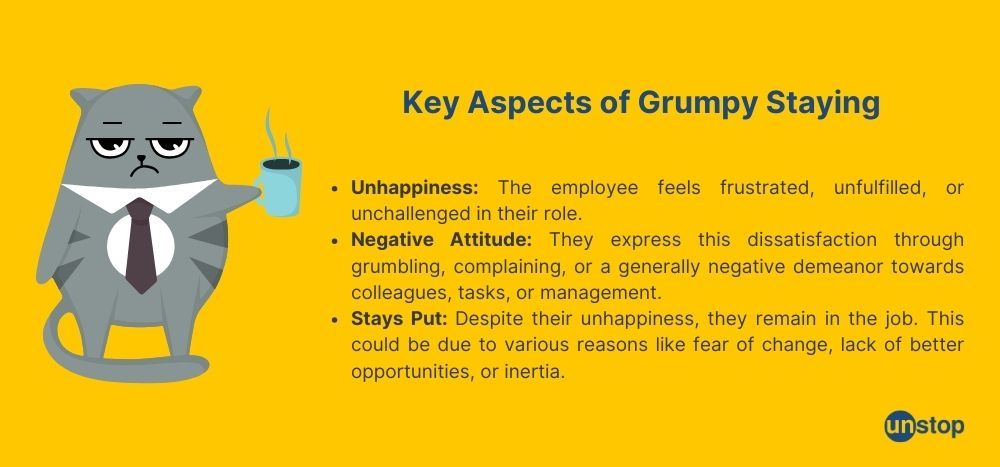
Grumpy Staying vs Other Workplace Behaviors
Grumpy staying differs from other forms of workplace dissatisfaction. Unlike someone who is temporarily unhappy, a grumpy stayer shows persistent grumpiness. Their negative mindset lasts for months or even years.
They do not just have bad days; they have a bad attitude that lingers. It's different from other workplace behaviors:
- Quiet Quitting: Quiet quitters essentially withdraw effort while fulfilling minimum expectations. Grumpy stayers express their discontent openly.
- Burnout: While burnout can lead to negativity, it usually stems from exhaustion, not mere dissatisfaction with the work itself.
Also Read: Navigating burnout as an HR professional.

Why do Grumpy Stayers not Leave?
Grumpy stayers, those perpetually disgruntled employees who stick around despite their negativity, can be a puzzle for HR and managers.
Here are some of the main reasons why they might not leave:
- Fear of Change: The unknown can be scary. Grumpy stayers, despite their unhappiness, might have a certain comfort level in their current role and fear the challenges and uncertainties of finding a new job.
- Lack of Better Opportunities: The job market might be tight, or the employee may feel their skills aren't strong enough to land a better position elsewhere. This can lead to a feeling of being stuck and unable to leave.
- Financial Security: Leaving a job, even a disliked one, can disrupt financial stability. Grumpy stayers might prioritize the security of a steady paycheck and benefits over happiness at work, especially if they have dependents or significant financial obligations.
- Inertia: Sometimes, it takes a lot of effort to make a change. Even if they're unhappy, grumpy stayers might lack the motivation or energy to actively job search.
- Vested Benefits: Years of service can accrue valuable perks like health insurance, stock options, or generous vacation time. The prospect of losing these benefits can be a strong deterrent to leaving, even for a happier job.
- Loyalty (Misplaced or Otherwise): Some employees might feel a sense of loyalty to the company, even if it isn't reciprocated. This could be due to a long tenure, positive past experiences, or a belief that "the devil you know is better than the devil you don't."
- Unexplored Options: The employee might simply not be aware of all their options. They might be stuck in a mindset that their current role defines their career path, and HR hasn't provided opportunities for growth or exploration within the company.
Recognizing the Signs
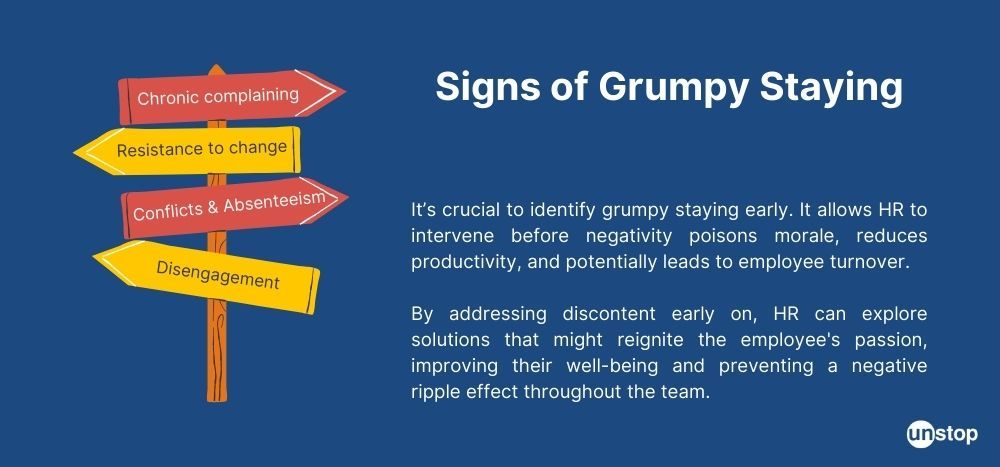
Key Behaviors
Grumpy staying often shows through chronic complaining. Employees who frequently voice dissatisfaction may be signalling deeper issues. Resistance to change is another sign. Refusing new ideas or processes can indicate a negative mindset.
Engagement Changes
Changes in engagement levels are crucial indicators. A once enthusiastic employee becoming indifferent could mean trouble. Observing shifts in attitude helps recognize early warning signs.
Frequent Conflicts
Conflicts with coworkers or managers can reveal underlying irritability. Frequent disagreements disrupt teamwork and lower morale. Such conflicts often point to an irritable disposition.
Absenteeism
Increased absenteeism is a subtle yet significant sign. Employees taking more sick days or arriving late regularly might be experiencing grumpy staying. Keeping track of attendance patterns can offer insights.
Exploring the Causes
We delved into the reasons why grumpy stayers don’t leave a job they dislike. But what are the reasons for grumpiness appearing in the first place? Let’s find out:
Job Dissatisfaction
Many employees stay grumpy due to job dissatisfaction. They may feel undervalued or unappreciated. Lack of growth opportunities can also be a major cause. When workers see no path for advancement, they lose motivation. This frustration builds over time, leading to a negative attitude.
Toxic Work Environments
A toxic work environment can be another significant factor. Bullying, harassment, and poor management contribute to this issue. Employees in these settings often feel stressed and unsupported. Such environments drain their creativity and enthusiasm.
Personal Circumstances
Personal circumstances also play a role. Financial responsibilities, location preferences, or other issues might force someone to stay in an unsatisfying job. Family obligations can limit their ability to seek new opportunities. These factors make it difficult for them to leave, even if they are unhappy.
Cultural Mismatches
Cultural mismatches within an organization can lead to similar frustration. Employees may feel out of place if their values don't align with the company’s culture. This misalignment creates discomfort and dissatisfaction.
Understanding the Impact
Personal Well-being
Persistent grumpiness affects personal well-being. It can lead to stress, anxiety, and even depression. Grumpy attitudes at work can also impact physical health. Headaches, fatigue, and other ailments might arise.
Decreased Productivity
Grumpy staying directly affects productivity. Employees often feel less motivated. Their negative mood can lead to more mistakes and slower work. This reduces overall output. Teams struggle to meet deadlines.
Poor Team Morale
The phenomenon of grumpy staying harms team morale. Negative feelings spread quickly. One person's bad mood can affect others. This creates a stressful environment. People may start to avoid collaboration.
Customer Relationships
Grumpy staying impacts customer relationships, too. Unhappy employees provide poor service. Customers notice this change in attitude. They may feel undervalued and take their business elsewhere. This leads to a loss of revenue.
Innovation Decline
Innovation suffers due to grumpy staying. Creative ideas require a positive mindset. When employees feel down, they lack enthusiasm for new projects. This stifles potential advancements and growth within the company.
Higher Turnover Rates
There is a cyclical effect with grumpy staying. Disengaged employees are more likely to leave their jobs. High turnover rates increase stress for those who remain. They face heavier workloads and decreased job satisfaction.
Further Disengagement
Remaining employees may become disengaged as well. Seeing colleagues leave can lower their expectations and motivation. The cycle continues, leading to more resignations and ongoing issues.
Addressing the Issue
Open Communication
Managers should encourage open communication. Employees need to feel heard and valued. Regular check-ins can help identify underlying issues early. This allows management to address concerns before they escalate.
Support Systems
Providing support systems is crucial. Offering access to counseling or mentorship programs can make a big difference. Supportive leadership shows employees that their well-being matters. This can improve their attitude and reduce grumpiness.
Also Read: The complete guide to priortizing employee mental health
Positive Environment
Creating a positive work environment helps a lot. Recognize achievements and celebrate successes. Foster teamwork and collaboration. These efforts build a sense of community and belonging.
Professional Development
Offer professional development opportunities. Employees who see growth potential are more engaged. Training sessions, workshops, and courses keep skills sharp. Investing in employee growth reduces the likelihood of them feeling stuck.
Clear Expectations
Set clear expectations and goals. Employees should know what is expected of them. Clear guidelines reduce confusion and conflict. It also helps them stay focused on their responsibilities.
Flexibility and Balance
Provide flexibility and work-life balance options. Flexible hours or remote work can alleviate stress. Employees with better balance are often happier and more productive. This approach addresses many common problems related to grumpy staying.
Taking Action: Addressing Grumpiness with Empathy
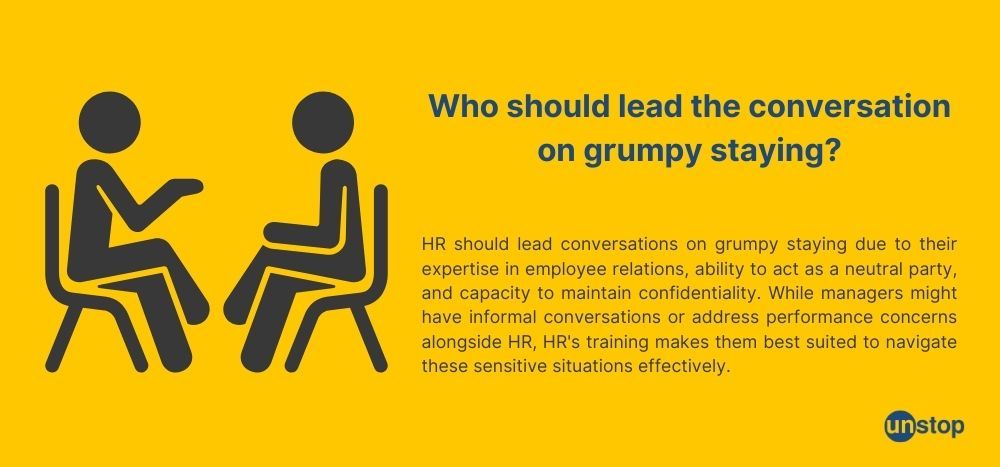
Before the Conversation
Here's what an HR professional should consider before addressing a grumpy stayer:
- Gather Information: Document specific instances of grumpy behavior. Focus on observable actions and their impact, not subjective interpretations of the employee's mood.
- Consider Context: Are there any recent changes at work or in the employee's personal life that might be contributing to their negativity?
- Review Performance: Has there been a decline in performance or quality of work?
- Maintain Confidentiality: Ensure the employee feels comfortable speaking openly.
Sample Conversation
Setting: Private meeting space
HR: "Thanks for meeting with me today. I wanted to have a conversation about something I've noticed lately. You seem a little less engaged than usual. Is everything okay?"
Employee: (Shrugs) "Things are fine, I guess."
HR: "I understand if you're not comfortable sharing, but I'm here to support you. Has anything happened at work or outside of work that might be affecting your mood?" ( Use empathetic tone )
Employee: (Hesitates) "Well, the workload has been pretty heavy lately, and I haven't felt very challenged in my role."
HR: "That's valuable feedback. Can you elaborate on what kind of challenges you'd like to see?" (Demonstrate active listening )
Employee: "I miss the problem-solving aspects of the job. Lately, it feels more repetitive."
HR: "I see. We might be able to explore some opportunities to re-energize your role. Have you considered taking on a new project or participating in a training program to develop new skills?" ( Offer solutions )
Employee: "Actually, there was a new software program mentioned during the last team meeting. I might be interested in learning more about that."
HR: "That's fantastic! We can definitely set you up with some training materials or connect you with a colleague who's familiar with the program." ( Positive reinforcement )
HR: "Is there anything else I can do to support you or improve your experience here?" ( Open the door for further discussion )
Employee: "For now, I think the training sounds good. But I appreciate you checking in."
HR: "Absolutely. My door is always open if you need anything. We can also schedule a follow-up meeting to discuss your progress with the training." ( Offer ongoing support )
After the Conversation
After your conversation with a grumpy stayer, measuring their change in behavior is crucial. Here are some steps you can take:
1. Schedule Follow-Up Meetings:
- Set a timeline: Schedule follow-up meetings based on the action items discussed. If the solution involves training, schedule a check-in after completion. For broader changes, set meetings at regular intervals (e.g., bi-weekly or monthly) to assess progress.
- Focus on specifics: During these meetings, don't just ask if they're "feeling better." Focus on specific behavioral changes you're hoping to see. For example, if they complained about workload, discuss their experience with task delegation or time management strategies.
2. Monitor Performance Trends
- Performance reviews: Use existing performance review mechanisms to track any improvement in performance metrics. This could include project completion rates, quality of work, or adherence to deadlines.
- Peer feedback: If the grumpy stayer's negativity impacted colleagues, consider anonymous surveys or informal feedback sessions to gauge if the team dynamic has improved.
- Self-assessment: Provide the employee with a self-assessment tool to track their own progress on goals related to their behavior or performance.
3. Encourage Open Communication
- Open-door policy: Reiterate your open-door policy and encourage the employee to come to you with any concerns or updates on their progress. This allows for early identification of any issues that might hinder their improvement.
- Anonymous feedback channels: Consider setting up anonymous feedback channels where employees can report observations about the grumpy stayer's behavior. This can provide valuable insights without singling anyone out.
Find out the top ways to get accurate feedback from employees.
4. Track Employee Engagement
-
Engagement surveys: If your company conducts employee engagement surveys, track the grumpy stayer's responses over time. Do their answers regarding satisfaction, motivation, and overall company culture reflect a positive shift?
Remember: Change takes time. Be patient and consistent with your follow-up, offering support and encouragement along the way. Celebrating small improvements can make a big difference in motivating the employee to continue on a positive trajectory.
When Grumpy Staying Continues
If, after addressing a grumpy stayer and implementing solutions, their behavior doesn't improve, there are a series of steps HR can take to manage the situation effectively:
- Document Continued Issues: Maintain a record of specific instances of negative behavior or performance issues. This documentation will be crucial if further action becomes necessary.
- Investigate Underlying Causes: Schedule another meeting with the employee to delve deeper. Are there personal circumstances impacting their work? Is the role truly a bad fit, or are there specific aspects that can be adjusted?
- Performance Improvement Plan (PIP): If performance has declined, consider a formal PIP outlining specific goals and expectations, along with a timeline for improvement. Offer coaching and support throughout the PIP period.
- Explore Internal Opportunities: If the role is the primary source of dissatisfaction, see if there are internal transfer opportunities that might be a better fit for the employee's skills and interests.
- Consider Alternative Solutions: Depending on the severity of the situation, explore alternative solutions like reduced workload, temporary leave of absence, or a change in work schedule (if applicable).
- Termination as a Last Resort: If all other efforts fail, and the employee's negativity is disrupting the workplace or their performance remains unsatisfactory, termination might be a necessary last resort. Ensure all proper protocols and procedures are followed in accordance with company policy and labor laws.
Important Considerations:
- Maintain Open Communication: Keep the employee informed throughout the process. Explain the expectations and consequences associated with each step.
- Focus on Solutions: Always prioritize finding ways to help the employee succeed, if possible.
- Document Everything: Maintain a clear and detailed record of all conversations, interventions, and outcomes.
- Seek Guidance: Consult with legal counsel or HR advisors if needed, especially when considering disciplinary action.
Remember, the goal isn't to punish the employee but to create a positive and productive work environment for everyone. By taking a proactive approach and exploring solutions, HR can address the issue of grumpy staying and potentially retain a valuable employee who might just need the right support to thrive.
Closing Thoughts
Grumpy staying presents a challenge for HR professionals. By understanding the root causes, negative impacts, and clear signs of this behavior, you can proactively address the issue. The sample conversation and follow-up strategies outlined in this article provide a roadmap to engage with disgruntled employees, explore solutions, and foster a more positive work environment.
Remember, the goal isn't simply to eliminate negativity, but to create a work environment where employees feel valued, motivated, and able to contribute their best selves.
Frequently Asked Questions
1. What is grumpy staying?
Grumpy staying refers to a persistent state of irritability or dissatisfaction. It’s more than just a bad mood. It’s a lingering bad attitutde towards your job role or organization.
2. What are the common signs of a grumpy employee?
- Frequent complaints: Regularly expressing dissatisfaction.
- Negative body language: Closed posture, frowning, sighing.
- Isolation: Avoiding social interactions with colleagues.
- Low enthusiasm: Lack of interest or motivation in their work.
- Irritability: Easily frustrated or angered.
3. How can I approach a grumpy employee about their behavior?
- Private setting: Discuss the issue in a confidential and private environment.
- Be empathetic: Show understanding and concern for their feelings.
- Use specific examples: Point out particular instances of negative behavior.
- Offer support: Ask if there are underlying issues and how you can help.
- Focus on impact: Explain how their behavior affects the team and workplace.
4. What strategies can help improve a grumpy employee’s attitude?
- Encourage open communication: Foster a culture where employees feel safe to express concerns.
- Provide feedback: Offer constructive feedback regularly.
- Promote work-life balance: Encourage breaks and manage workloads to reduce stress.
- Recognize achievements: Acknowledge and reward positive contributions.
- Offer professional development: Provide opportunities for skill growth and career advancement.
5. What if the grumpy behavior is due to personal issues?
- Show empathy: Be understanding and offer support.
- Provide resources: Suggest employee assistance programs or counseling services.
- Be flexible: Consider temporary adjustments to workload or schedule if appropriate.
- Maintain boundaries: Ensure the conversation stays professional and focused on behavior impacting work.
6. How can I prevent a grumpy attitude from spreading in the workplace?
- Address issues early: Don’t let negative behavior go unchecked.
- Set clear expectations: Ensure all employees understand the expected workplace conduct.
- Promote positivity: Create a positive work environment through team-building activities and recognition programs.
- Lead by example: Demonstrate a positive attitude and effective stress management.
7. What are the potential causes of a grumpy demeanor in employees?
- Work-related stress: High workload, tight deadlines, or unclear expectations.
- Lack of recognition: Feeling undervalued or unappreciated.
- Poor work environment: Unpleasant physical conditions or negative company culture.
- Personal issues: Health problems, family issues, or financial stress.
- Burnout: Prolonged periods of stress and overwork.
8. How can I measure improvement in a grumpy employee’s behavior?
- Regular check-ins: Have ongoing one-on-one meetings to discuss progress.
- Feedback from colleagues: Gather input from team members on any changes in behavior.
- Self-assessment: Encourage the employee to reflect on their behavior and attitude.
- Performance metrics: Monitor productivity and engagement levels.
9. What should I do if there is no improvement in the employee’s behavior?
- Document the behavior: Keep detailed records of instances and interventions.
- Follow up formally: Schedule formal performance reviews to discuss ongoing issues.
- Consider further action: If behavior doesn’t improve, explore disciplinary measures in line with company policies.
10. What kind of training can help address a grumpy attitude?
- Soft skills training: Offer programs on communication, emotional intelligence, and conflict resolution.
- Stress management: Provide training on stress reduction techniques and resilience.
- Leadership development: For managers, training can help them better support their teams and address issues early.
Suggested Reads:
I’m a reader first and a writer second, constantly diving into the world of content. If I’m not writing or reading, I like watching movies and dreaming of a life by the beach.
Login to continue reading
And access exclusive content, personalized recommendations, and career-boosting opportunities.
Subscribe
to our newsletter
Blogs you need to hog!
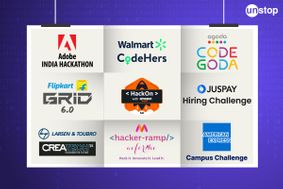
Organize Hackathons: The Ultimate Playbook With Past Case Studies

What is Campus Recruitment? How To Tap The Untapped Talent?

Lateral Hiring: A Complete Guide To The Process, Its Benefits, Challenges & Best Practices
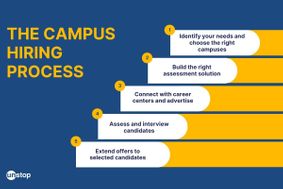








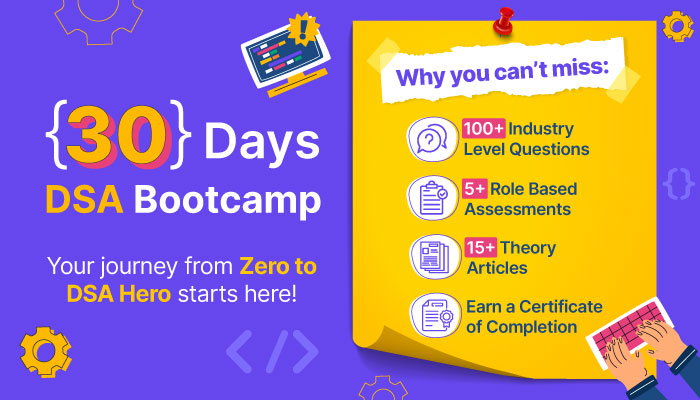



Comments
Add comment